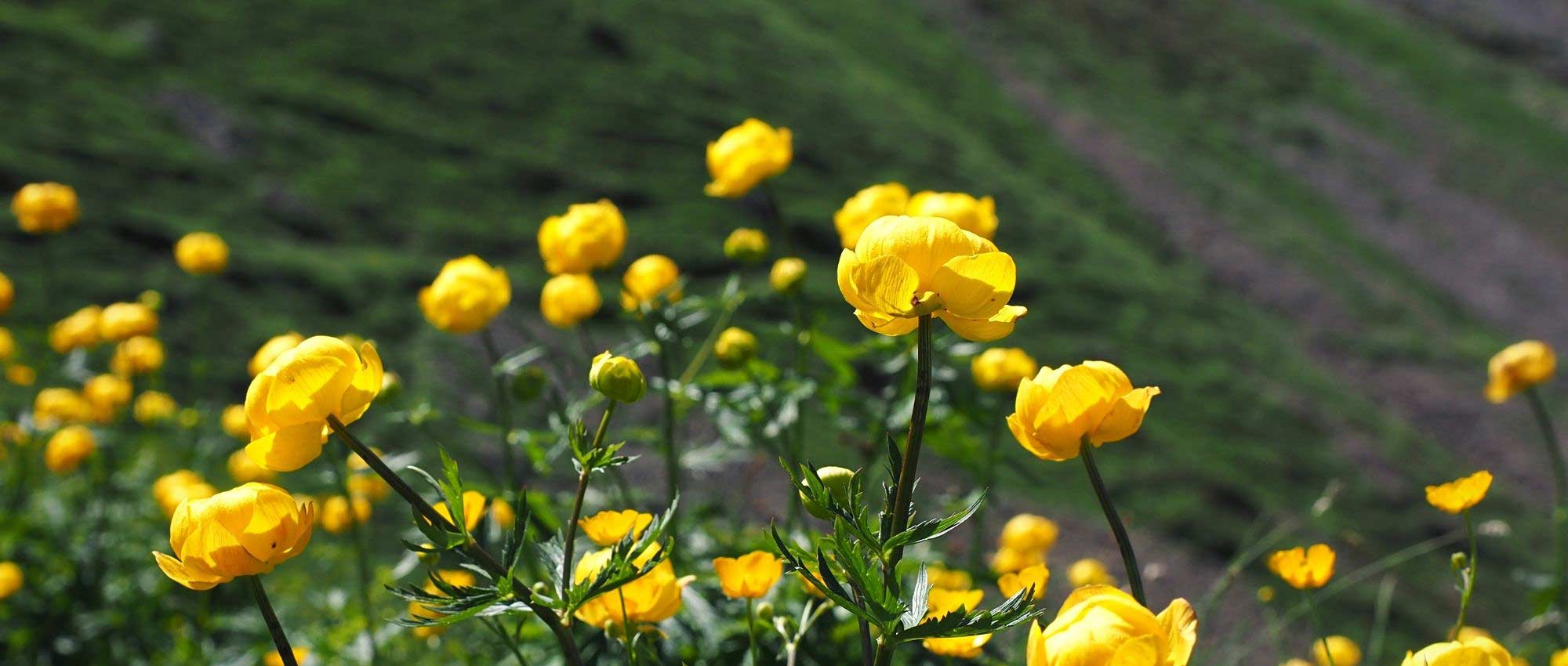
Trollius: planting, growing, and care
Contents
Trollius in a nutshell
- We appreciate the globeflower for its very bright flowering, with golden or orange buds resembling buttercups!
- It has a light, natural, and wild style!
- Robust and hardy, it’s an easy plant to grow.
- Its only requirement: that the soil does not dry out!
- It’s an ideal plant for the edge of a pond.
A word from our Expert
Trollius, or globeflowers, are herbaceous perennials with rounded, globular, and very bright flowers! They resemble large buttercup-like flowers, made up of several rows of petals. Trollius bloom in late spring, and the flowering can sometimes extend into late summer. We appreciate their vibrant flowering, which is unmatched for brightening up a border! There are different varieties, with flowers in yellow, orange, or even cream white. Their flowers rise above a tuft of beautifully divided foliage. There is also a dwarf species: Trollius pumilus, which does not exceed 30 cm in height!
Despite its light and delicate flowering, Trollius is a robust plant, with no particular issues! It is quite hardy, as it withstands temperatures down to -15 to -20 °C, and is suitable for all regions, even mountainous ones! It is not very susceptible to diseases and is very easy to grow, provided the soil remains moist! It is therefore ideal at the edge of a border or stream, in full sun or partial shade. It dislikes dry soils and hot summers.
The bright flowering of Trollius does not prevent it from maintaining a very natural appearance! It is perfect in a wild-style garden, alongside ferns, reeds, Japanese primroses, irises… Similarly, Trollius benefits from being planted in masses! The countless yellow flowers will create a stunning effect. It is a plant that is not often found in gardens, but it certainly deserves its place! Discover all our tips for successful cultivation: where to plant it, how to care for it, which plants to associate it with, and more.
Botany
“`html
Botanical data
- Latin name Trollius sp.
- Family Ranunculaceae
- Common name Globeflower
- Flowering between May and July
- Height between 15 cm and 1 m
- Exposure sun or partial shade
- Soil type cool to moist, rather heavy
- Hardiness -15 to -20 °C
Globe flowers comprise between 25 and 30 species of herbaceous perennials, typically featuring yellow, orange, or cream-white flowers. They are native to temperate regions of the Northern Hemisphere, particularly in Europe, Asia, and North America. The greatest diversity of species is found in Asia. The Trollius europaeus is found wild in France, especially in mountainous areas. It typically grows in wet meadows, pastures, sometimes in clearings, by water bodies, or on marshy soils. It can be found at altitudes of nearly 2,000 m, which explains its excellent hardiness!
It could be confused with the marsh marigold, Caltha palustris, which is also a plant of moist soil and bears yellow flowers resembling buttercups. However, the leaves of the globe flower and the marsh marigold are completely different.
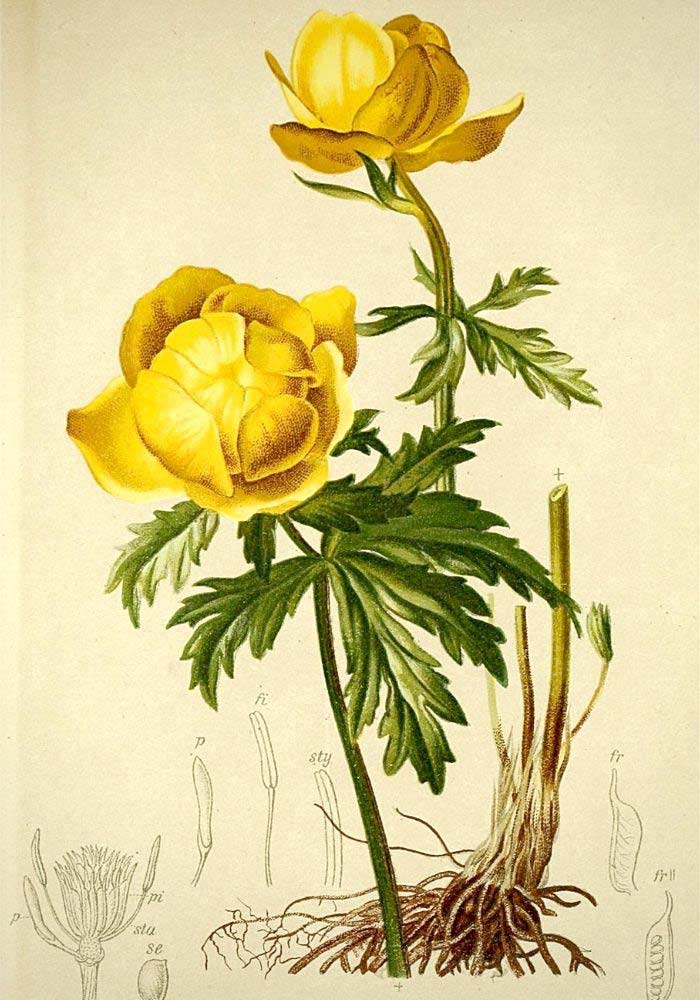
Trollius europaeus: Botanical illustration
The globe flower belongs to the buttercup family, the Ranunculaceae… which is not surprising, given its yellow, globular flowers with numerous petals! It belongs to the same family as the buttercup, which is also a buttercup, Ranunculus repens.
Etymologically, its name comes from the German Trol, meaning “globe” or “sphere,” referring to the shape of the flower.
Globe flowers are perennials that form clumps of dissected leaves and upright, thick, robust stems bearing the flowers. When in bloom, globe flowers generally measure between 50 cm and 1 m for the tallest. And only 15 to 30 cm high for the dwarf globe flower, Trollius pumilus!
Globe flowers typically bloom from May to July, but sometimes until September, depending on the varieties and climate.
The flowers are most often bright yellow, with a beautiful almost golden hue. Some species have orange flowers, like Trollius asiaticus, while a few varieties have cream-white flowers (for example, Trollius ‘Alabaster’).
Globe flowers bear solitary flowers at the top of their stems, usually globular and well-rounded. This gives the globe flower its nickname of “golden ball,” as well as its English nickname of “globe flower“! This spherical shape is due to the petals that are incurved over the flower. The Trollius pumilus, however, has flatter flowers, with a single row of well-opened petals. The flowers of globe flowers can thus be single, double, or semi-double, depending on the number of petals they comprise. They measure between 3 and 5 cm in diameter and consist of petals generally inserted in several rows, with a bouquet of yellow stamens at the centre. They resemble the flowers of the buttercup, which is, after all, from the same family! Some varieties have the particularity of bearing, upright at the centre of the flower, reduced, very fine petals. This is the case, for example, with ‘Golden Queen’.

The flowers of Globe flowers can take on different shades and shapes: Trollius ‘Lemon Queen’, Trollius chinensis ‘Golden Queen’, Trollius ‘Alabaster’, and Trollius asiaticus (photo: Chan)
Globe flowers also have beautiful, dissected, palmate leaves of dark green colour. They are divided into three to five lobes, which are themselves subdivided into finely toothed segments. Two types of leaves can be distinguished: large, shiny, well-developed basal leaves, borne on a petiole, and small cauline leaves (= inserted on the stem), without a petiole.
The flowers of the globe flower are pollinated solely by flies of the genus Chiastocheta. They need them for reproduction. However, after fertilisation, female Chiastocheta lay their eggs in the flowers; then, when they hatch, the larvae feed on the developing seeds. Fortunately, there are always a few seeds that escape this predation, allowing the globe flower to reseed naturally. This is a mutualistic system, where both the plant and the insect benefit from this interaction!
The seeds of the globe flower are enclosed in follicles, dry fruits that open at maturity. Each floral receptacle thus bears a cluster of follicles.

The leaves of Trollius pumilus and those of Trollius europaeus (photo Rosenzweig), the fruits of Trollius europaeus (photo Kristian Peters)
“`
Read also
12 perennials for heavy, wet soilThe main varieties of trollius
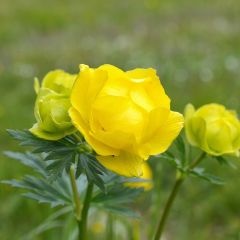
Trollius europaeus
- Flowering time June, July
- Height at maturity 60 cm
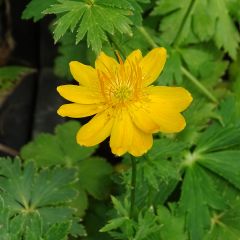
Trollius chinensis Golden Queen
- Flowering time June to October
- Height at maturity 80 cm
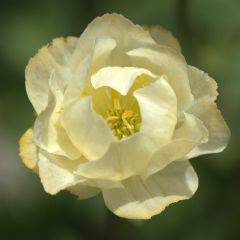
Trollius x cultorum Alabaster
- Flowering time June to October
- Height at maturity 60 cm
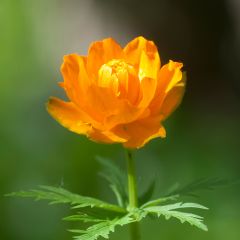
Trollius asiaticus
- Flowering time June, July
- Height at maturity 50 cm
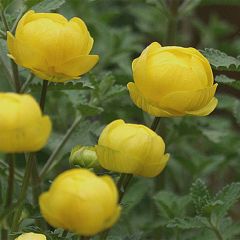
Trollius x cultorum Lemon Queen
- Flowering time June to October
- Height at maturity 60 cm
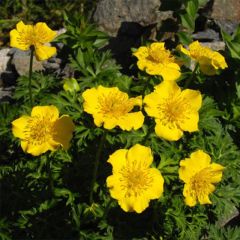
Trollius pumilus - Dwarf Globeflower
- Flowering time June to October
- Height at maturity 15 cm
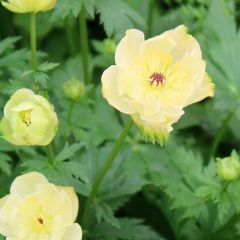
Trollius x cultorum Cheddar
- Flowering time June, July
- Height at maturity 60 cm
Discover other Trollius
View all →Available in 0 sizes
Available in 3 sizes
Available in 1 sizes
Available in 1 sizes
Available in 1 sizes
Available in 1 sizes
Available in 2 sizes
Available in 3 sizes
Available in 1 sizes
Available in 1 sizes
Planting
Where to plant?
Trollius thrive in non-burning sunlight or partial shade. However, if they are planted in full sun, it is important that the soil remains constantly moist. Absolutely avoid overly hot and dry conditions!
They appreciate deep, humus-rich, fertile soils, and heavy ground does not deter them. They can also manage with ordinary garden soil, as long as it does not dry out. We recommend adding well-decomposed manure or compost at the time of planting. They also prefer calcareous soils.
The best option is to place them by the edge of a pond or stream: find a spot where the soil remains moist. However, they do not like their roots to be completely submerged! You can elevate them slightly above the water level. You can also plant them in a border, such as a mixed border, where the soil stays cool. Winter moisture will not harm them, but summer drought would be fatal. In any case, do not hesitate to plant a large number of young plants together, as the effect will be truly beautiful!
It is also possible to plant Trollius in pots, but care must be taken to ensure that the substrate does not dry out!
When to plant?
Plant Trollius in spring, in March-April, or in autumn, around October. These are the most suitable times for their installation.
How to plant?
- Place the root ball in a basin filled with water to rehydrate it.
- Dig a planting hole two to three times the size of the root ball.
- Add well-decomposed compost to enrich the soil.
- Remove the Trollius from its pot and plant it.
- Replace soil around the clump and gently firm it down with the palm of your hand.
- All that’s left is to water generously.
- You can also apply organic mulch to help the soil retain its moisture.
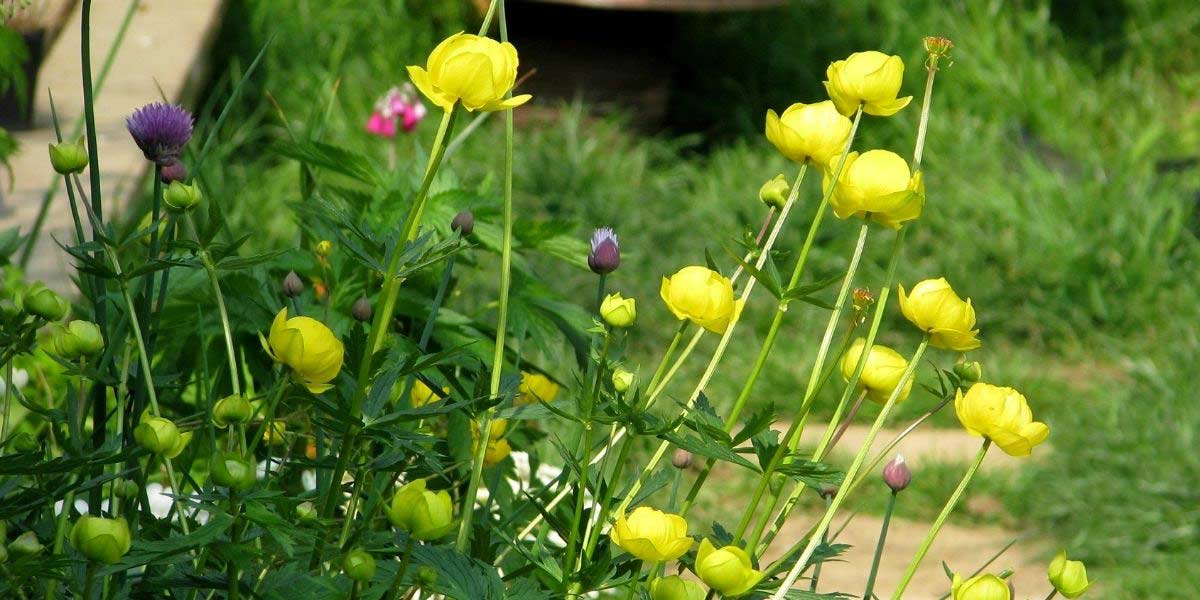
Trollius europaeus (photo peganum)
Care
Robust and hardy, trollius is a low-maintenance plant with just one requirement: that the soil remains moist. Therefore, do not hesitate to water generously as soon as you notice it starting to dry out (hence the importance of choosing a location where the soil stays cool to moist). Be particularly cautious of summer droughts.
We recommend placing a layer of organic mulch around the clump, made from materials such as RCW (ramial chipped wood) or fallen leaves. This will not only help limit the growth of weeds but also keep the soil cool for longer while enriching it through decomposition!
The trollius is not very susceptible to diseases and pests. However, it can occasionally be affected by powdery mildew, a fungal disease characterised by the appearance of a white fluff on the leaves.
As soon as you notice the flowers wilting, we advise cutting back the stems at the base of the clump to encourage the plant to produce new flowers! Similarly, trim the faded foliage in autumn.
Feel free to cut the flowers for creating bouquets: they have good vase life!
Multiplication
The best technique for multiplying Trollius is to divide the clumps. This is a much quicker and easier solution than sowing.
Sowing
It is possible to sow troll seeds, but the germination rate is not very high, and the seeds can take a long time to germinate, sometimes up to a year! We recommend using fresh seeds, harvested recently, as their germination rate will be better.
The seeds require a cold period to germinate: you can either sow them directly in pots and place the pots outside, or place the seeds in the refrigerator for 6 to 8 weeks before sowing them.
- Prepare pots with a special sowing compost.
- Sow the seeds, then cover them with a thin layer of substrate.
- Water gently.
- Place the pots in a bright location, out of direct sunlight, ideally at a temperature of around 10 °C.
- Keep the substrate slightly moist until germination.
Don’t worry if you don’t see them germinate in the following weeks. They take at least a month to germinate, but sometimes up to a year. So be patient and don’t discard your seedlings too quickly if you think they haven’t worked; you might be in for a pleasant surprise! As soon as the young seedlings are large enough to handle, you can repot them into individual pots. Plant them in the ground in autumn.
Sometimes, globeflowers may self-seed spontaneously in the garden.
Division of clumps
If you have well-established clumps of globeflowers that have been in place for several years, you can divide them. Do this at the very beginning of spring or in autumn. Do not do it too often, no more than once every three to four years, or preferably every five years, to allow them time to regenerate.
- Identify a well-established clump that has been in place for at least four years.
- Dig it up, making sure to dig wide enough not to damage it.
- Gently separate the roots into several parts.
- Replant immediately in a new location, after preparing the soil.
- Water thoroughly to aid recovery.
Pairing ideas
Trollius always creates a stunning effect when planted in masses. So whatever plants you pair them with, don’t hesitate to plant a large number to achieve a multitude of golden spheres by late spring!
We recommend placing Trollius at the edge of a pond, alongside other plants that enjoy cool to moist soils! Plant alongside ferns, particularly Osmunda or Matteuccia. Add a beautiful mass of vegetation with reed (Phragmites australis), Giant Reed (Arundo donax), or Gunnera. For flowering options, you might choose Japanese Primroses, Persicaria bistorta, or meadowsweet, Filipendula ulmaria. Also, discover the splendid light purple flowering of Cirsium rivulare ‘Atropurpureum’. You can also enjoy the fine foliage of grasses, such as Carex elata ‘Aurea’ or Acorus gramineus. Don’t forget the unique Juncus effusus ‘Spiralis’.
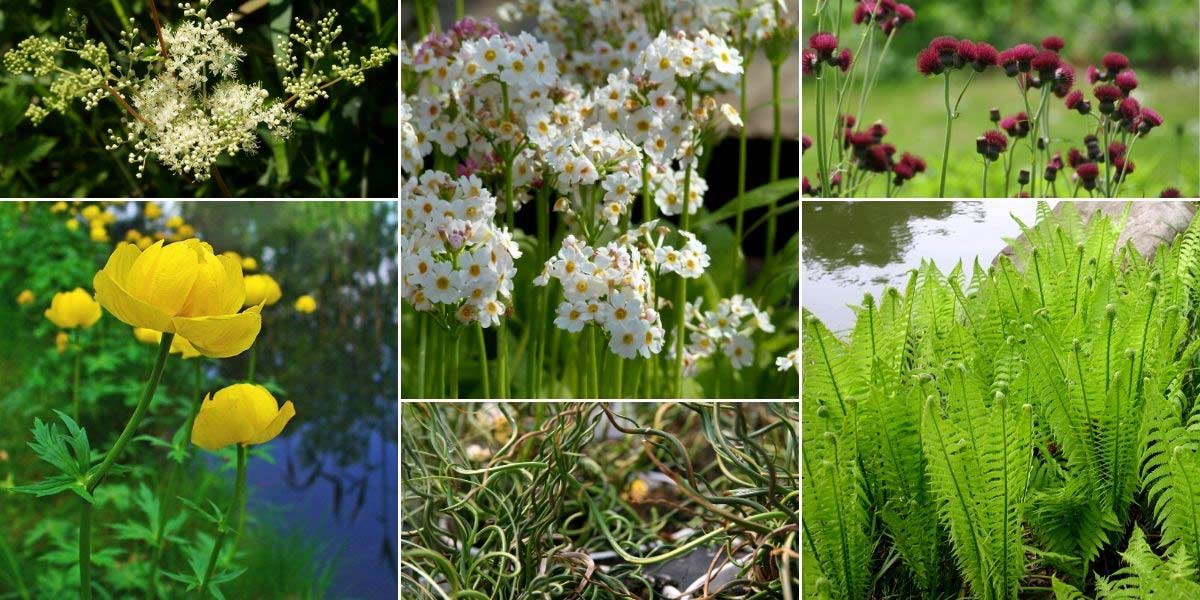
Feel free to place Trollius at the edge of a pond, alongside perennials that enjoy cool to moist soils! Filipendula ulmaria (photo Hans Hillewaert), Primula japonica ‘Alba’, Cirsium rivulare ‘Atropurpureum’ (photo Jean Jones), Trollius europaeus (photo H. Zell), Juncus effusus ‘Spiralis’ (photo David J. Stang) and Matteuccia struthiopteris (photo Ryan Somma)
You can also create a stunning border in cool soil by pairing Trollius with Japanese iris (Iris ensata), astrantias, avens, Lychnis flos-cuculi… Also enjoy the delicate flowering of Astilbes! Don’t hesitate to incorporate plants with generous foliage to create a very natural effect: hostas (for example, the variety ‘Empress Wu’), alchemillas, Gunnera, Rodgersia, ferns… Also enjoy the golden foliage of Lysimachia nummularia ‘Aurea’!
Useful resources
- Discover our entire range of trollius!
- To pair trollius at the edge of a pond, check out our range of wetland perennials
- Article: Pairing trollius
- Subscribe!
- Contents































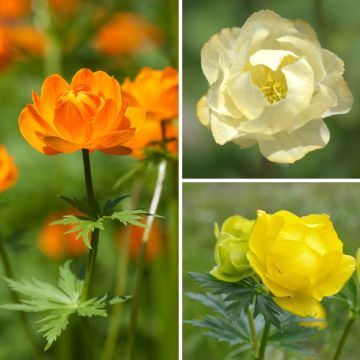



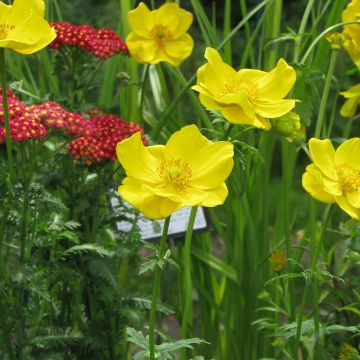
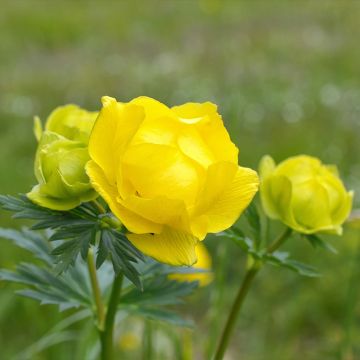




Comments